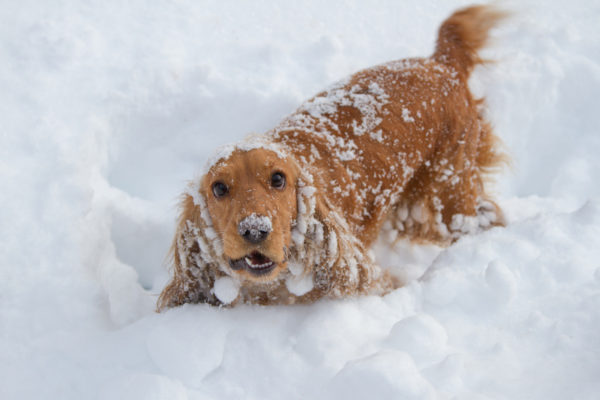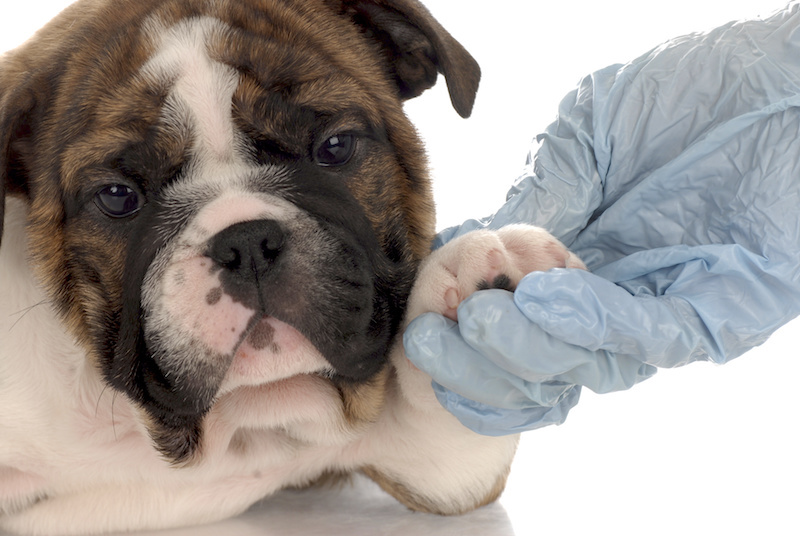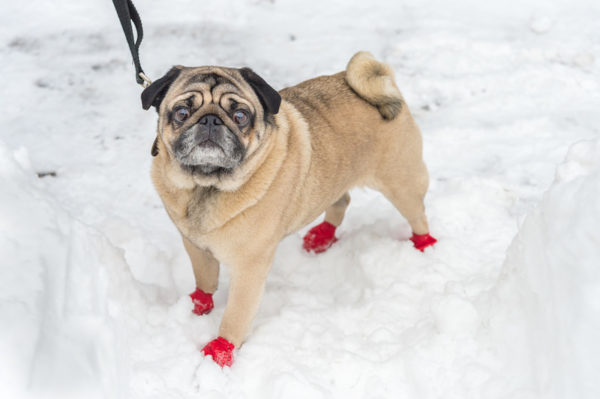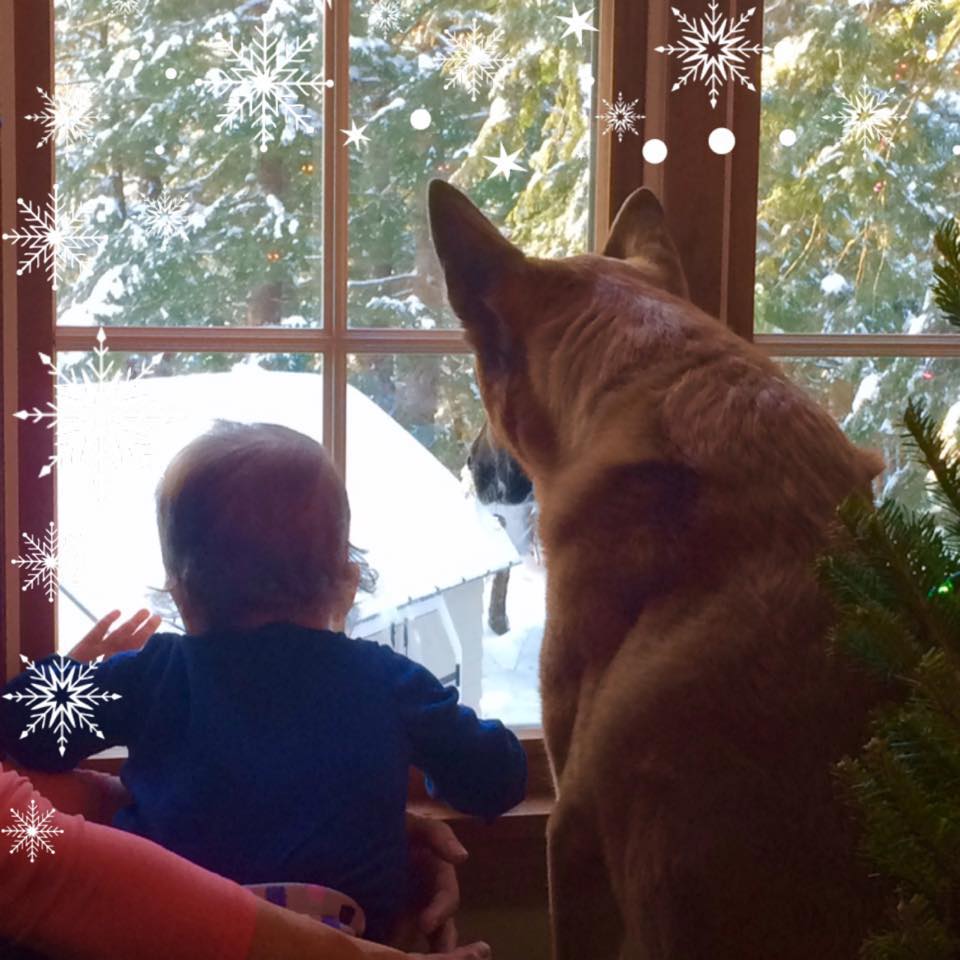In this frigid weather, we humans bundle up from head to toe if we venture outside.
Our pets on the other hand …
You might think that their furry coats provide all the protection they need, but not always and their paws are also vulnerable to frostbite and other cold-related injuries. When the temperature dips below, say 5 or 10 degrees, you really need to be extra cautious. Right now, here in Maine, we are below zero.
Sore paws
Smaller dogs (and other creatures) may be more prone to cold-related injuries than larger, more athletic dogs, but either way, you should pay close attention to subtle signs that their paws may hurt.
- High stepping or lying down and refusing to move when outside.
- They yelp or squeak when they walk as if they’ve stepped on a tack.
- Licking and/or chewing their paws for several minutes when they come inside.
- Lameness, limping, or not being able to bear weight normally.
If you see any of these signs, take a look at your dog’s paws. They’re often pigmented, so you may have to look closely.
Do you see:
- redness?
- crusting?
- open sores?
- weeping areas?
Yes? No wonder they hurt.
It might be that the skin on their paws is dry and cracked — just like what can happen to humans in winter. Imagine that your fingers are dry and cracked or that you have several paper cuts and you dip them into salty water. Hurts like you know what.
If a dog has several fissures on his/her paws because of dry skin, they’ll be sensitive to things like the rock salt we often use outside in winter or even the direct cold. But you may not even realize something is wrong.
“Sometimes if you’re out on a walk you won’t notice anything because dogs are so rugged and resilient,” says Dr. Dave Moody, a veterinarian at Cumberland Animal Clinic. “But when you come in and they warm up they’ll chew their feet. It’s like if you were to have frostbite or your leg falls asleep. When the area wakes up again it feels funny. The same thing can happen to your dog.”
That’s why you need to be aware of the subtle signs.
You can help protect their paws by rinsing them or wiping them off with a damp cloth every time they come inside.
Frostbite
What about frostbite? Can that happen to pets? “Absolutely,” said Dr. Moody. “Just this week we treated a dog and a cat with frostbite on their feet. It usually shows up as redness or the tissue can dry and harden and slough off.”
Frostbite can also happen in the tip of the ears and/or tail. If you want to prevent it, limit your dog’s time outside, As for their feet, try putting on a pair of doggie boots. “They fill a couple of purposes,” Dr. Moody said. “They help prevent mechanical trauma to the feet from road salt or debris or ice and a little bit of a barrier can provide some thermal protection from the direct cold. The biggest problem is getting the dog to tolerate the boots without shaking them off or walking with a strange gait.”
A fashion parade of warm coats
Gudrun Cobb has a lot of experience trying to coax dogs into their winter boots. She agrees that it’s not always easy. She used to be a professional dog walker and now owns Uncommon Paws in Portland, Maine where during this unusually frigid winter, people are clamoring to buy items that will keep their pets warm and dry.
“I sell a lot of boots and coats,” she said. “Coats especially are a huge seller. It seems that everyone is dressing their dogs. From Maine made buffalo plaid and Goretex fleece lined winter coats to companies from Australia that make a beautiful buffalo plaid and shearling lined jean jacket. Then there are the seriously warm puffer coats and all-weather coats.”
Don’t forget the toenails!
Another problem that can plague dogs in cold weather is broken toenails. “If a dog’s toenails are too long they can get out there on the ice and start slipping,” said veterinarian Dr. Tom Netland from Cumberland Animal Clinic. “They can catch the tips of the toenail and fracture the nail. It’s a good idea to keep their nails trimmed.”
Hypothermia
Most pet owners do a great job of keeping their furry pets warm when it’s freezing outside. The important thing is to make sure you supervise them when they’re out. When they’re active, they’re usually ok. “If a dog is left outside, unsupervised and not moving around, that’s when they can get cold and in trouble,” said Dr. Moody.
Smaller pets are at greatest risk. Bundle them up, take them out to do their business and get them back inside again.
The first sign of hypothermia is shivering followed by lethargy, which means they don’t have any energy. A normal temperature for a dog is anywhere between 99.5 and 103 degrees. If it goes any lower than 98, you need to get the dog to a vet. Otherwise, try to raise his/her temperature slowly.
- Wrap the dog in warm blankets.
- Wrap a hot water bottle in a blanket or towel (important) and put it against the dog’s abdomen.
- Try getting the dog to drink something warm.
And what about cats?
Being someone who shares her home with three cats, I’m certainly not going to forget about keeping them safe. Rule number one for us is that none of them is allowed outside. It proved too dangerous for other cats we have loved. All it takes is one night of being stranded outside in below freezing weather.
If you’ve got barn cats, make sure they have a warm, dry place for shelter. And if there are any outdoor cats in your neighborhood, always take a second to thump the hood of your car before starting it. Some cats like to crawl under the hood because it’s a warm cozy place to curl up and sleep.
Dr. Netland added one more cat caveat that I’d never ever considered. Every year he sees at least one cat with burned paws from jumping on a wood stove. I don’t know how you could stop it from happening, but be forewarned.







I own dachshunds, so don’t really need to worry about this as you’ll be lucky to get them out in the cold!
That makes me laugh! I can probably picture it!